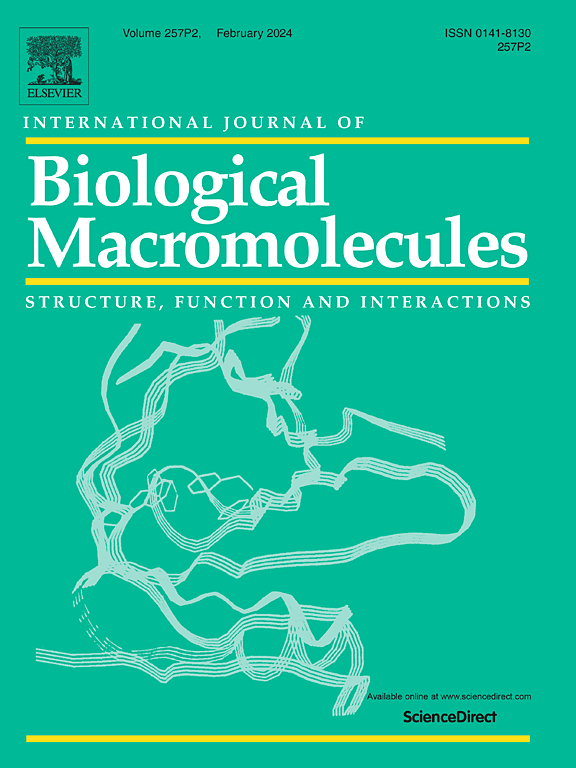Hyaluronic acid microneedle patch for transdermal delivery of frankincense and myrrh bioactives to alleviate inflammation and enhance diabetic ulcer healing
IF 8.5
1区 化学
Q1 BIOCHEMISTRY & MOLECULAR BIOLOGY
International Journal of Biological Macromolecules
Pub Date : 2025-06-01
DOI:10.1016/j.ijbiomac.2025.144831
引用次数: 0
Abstract
Chronic inflammation impedes the healing of diabetic ulcers (DUs), while P-glycoprotein (P-gp)-mediated drug efflux reduces the efficacy of conventional drug formulations. In this study, a novel liposome-mediated hyaluronic acid (HA) microneedle patch (E-Lipo@A-HMN) was developed for enhanced DUs healing via the transdermal delivery of Acetyl-11-keto-β-boswellic acid (AKBA) and β-elemene (ELE). The findings demonstrate that liposomal encapsulation enhances the solubility and bioavailability of ELE, and HA microneedles improve skin penetration and enable controlled drug release by providing a biodegradable, biocompatible scaffold that improves skin penetration and enables controlled drug release. Furthermore, our treatment protocol could effectively attenuate inflammation and promote fibroblast proliferation, collagen deposition and angiogenesis by inhibiting P-gp expression, enhancing intracellular drug accumulation and downregulating the PI3K/AKT/NF-κB signaling pathway. Compared to conventional therapies, E-Lipo@A-HMN exhibits better therapeutic performance, demonstrating enhanced anti-inflammatory activity and accelerated wound repair. Moreover, the treatment protocol displays an excellent biosafety profile. It offers a novel, safe, and effective therapeutic strategy for treating DUs with significant potential for clinical application.
透明质酸微针贴片用于经皮输送乳香和没药生物活性,以减轻炎症和促进糖尿病溃疡愈合
慢性炎症阻碍糖尿病溃疡(DUs)的愈合,而p -糖蛋白(P-gp)介导的药物外排降低了传统药物配方的疗效。在这项研究中,开发了一种新型脂体介导的透明质酸(HA)微针贴剂(E-Lipo@A-HMN),通过经皮递送乙酰-11-酮-β-乳香酸(AKBA)和β-榄香烯(ELE)来增强DUs的愈合。研究结果表明,脂质体包封提高了ELE的溶解度和生物利用度,而透明质酸微针通过提供可生物降解、生物相容性的支架来改善皮肤渗透和控制药物释放,从而改善皮肤渗透和控制药物释放。此外,我们的治疗方案可以通过抑制P-gp表达、增强细胞内药物积累和下调PI3K/AKT/NF-κB信号通路,有效减轻炎症,促进成纤维细胞增殖、胶原沉积和血管生成。与传统疗法相比,E-Lipo@A-HMN表现出更好的治疗效果,显示出增强的抗炎活性和加速伤口修复。此外,该治疗方案显示出良好的生物安全性。它为治疗DUs提供了一种新颖、安全、有效的治疗策略,具有重要的临床应用潜力。
本文章由计算机程序翻译,如有差异,请以英文原文为准。
求助全文
约1分钟内获得全文
求助全文
来源期刊
CiteScore
13.70
自引率
9.80%
发文量
2728
审稿时长
64 days
期刊介绍:
The International Journal of Biological Macromolecules is a well-established international journal dedicated to research on the chemical and biological aspects of natural macromolecules. Focusing on proteins, macromolecular carbohydrates, glycoproteins, proteoglycans, lignins, biological poly-acids, and nucleic acids, the journal presents the latest findings in molecular structure, properties, biological activities, interactions, modifications, and functional properties. Papers must offer new and novel insights, encompassing related model systems, structural conformational studies, theoretical developments, and analytical techniques. Each paper is required to primarily focus on at least one named biological macromolecule, reflected in the title, abstract, and text.

 求助内容:
求助内容: 应助结果提醒方式:
应助结果提醒方式:


